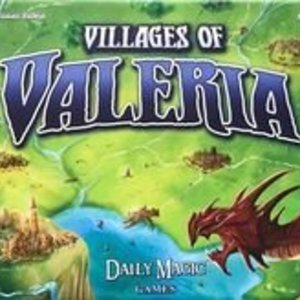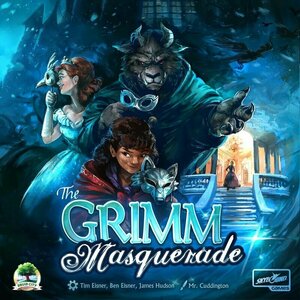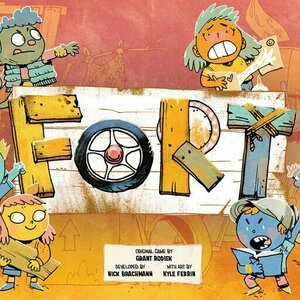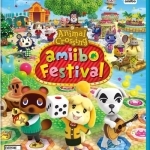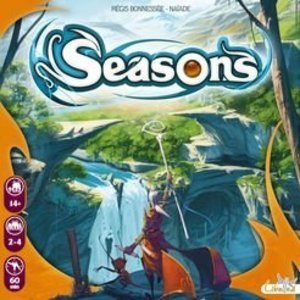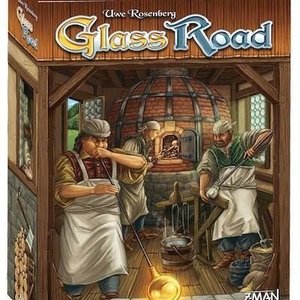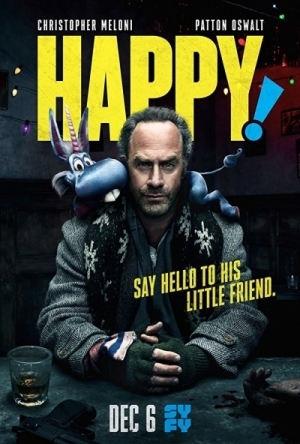Search
Search results
Purple Phoenix Games (2266 KP) rated Villages of Valeria in Tabletop Games
Jun 12, 2019
Oh, Valeria. How I do love thee! I have reviewed Valeria: Card Kingdoms (VCK) in the past and if you read that review you learned that it is my favorite game of all time (as of the date of this composition). I actually Kickstarted Villages of Valeria (VoV) before even playing VCK so this game was my introduction into the Valeriaverse. I feel obligated to publicly thank VoV for bringing me into one of my favorite gaming universes. But, how good IS this one?
In VoV you are a Duke/Duchess being charged by the King to found a new Capital City to replace the previous one that has been ravaged by the wars played out in VCK. The King has assigned you a castle to use as your HQ and expects the most enterprising Duke/Duchess to win the day by building the most flourishing village. Will you be able to create the resources necessary to build the most attractive buildings that adventurers will want to frequent? Or will you spend your time taxing your constituents to death?
DISCLAIMER: This review focuses on vanilla Villages of Valeria. We have all the released expansions and may do a review of them in the future. If we do, we will edit this review or link to the new review here. -T
VoV uses a handful of really great game mechanics that will be familiar to some gamers, but not intimidating enough to scare off new gamers, that really work well together to create an excellent gaming experience. I will address most of them here, but please do not use this review as a replacement for the rulebook, as I will not be addressing every single rule.
VoV is played over several rounds where every player will be taking a turn as the active player until someone has built the requisite number of buildings prescribed in the rulebook to trigger the end of the game. Each player starts with a castle card that provides a wild resource of your choice when you need to pay resources to build buildings on future turns. You are also given gold and a starting hand of cards in accordance with setup rules. Setup the decks of cards and create the offer rows for each and you are ready to play!
When you are the active player you will take an action from a list of five available actions: Harvest, Develop, Build, Recruit, and Tax. If you choose to Harvest on your turn you will draw three cards from either the face-up green building cards on the offer or blindly from the deck of green building cards. To Develop you will play a building card from your hand to the back of your castle, tucked underneath and upside down, to be used as the resources printed at the bottom of the card (wood, magic, stone, food). These resources are now available to be used for the build action (think of the brown and gray cards in 7 Wonders, if you’re familiar). When you take the Build action, you will be playing a building card from your hand to be built in the tableau in front of you. Since number of buildings is the end game trigger condition, you will be trying to build buildings as much as possible. All building cards have a cost printed on the left side of the card, and those costs will need to be paid for by using the gold you possess. You can use one gold on your own castle card as it provides a wild resource to you, and you can use one gold per card you have Developed previously for their resource benefit. You may even spend your gold to use an opponent’s resources (not their castle! – also akin to 7 Wonders neighbor resource purchasing). The catch here is that you lose that gold piece to your opponent, but they will not be able to use that resource until the beginning of their turn as active player. Most buildings will have benefits printed on them that either take effect immediately or when triggered by another action. When you Recruit an Adventurer, you are using your village’s buildings to attract them to your cause. Each Adventurer’s cost to recruit is printed on the side of the card, and these costs are paid by having the matching symbols on building cards in your village. Once recruited, these Adventurers can also enact conditional abilities similar to building cards, but usually will be advantages to final VP scores. By taking the Tax action you will take one gold from the bank and draw a building card from the offer or the deck.
Now this all seems pretty easy and I have only really mentioned one form of tension by blocking opponents’ use of their own resources if you spend a gold to use it on your turn. Since you reclaim all gold on your castle and resource cards in your village at the beginning of your turn this should cause no problems, right? Well, VoV also uses the follow mechanic that has been employed by other games previously. When you are the active player you choose which action you want to take on your turn, complete that action, and then the same action is offered to your opponents for them to take at a disadvantage. Example: I choose Tax as my action, so I take my gold and my card and my turn is over. Then, going around the table, each player can decide to follow my action but are only able to take a building card as a follow action. No gold. Each action has a Lead and Follow benefit, so you are always paying attention during the game, even on others’ turns because you might still benefit from the chosen actions.
Play continues like this with active player Lead actions and possible others’ Follow actions until someone triggers the end game condition. Then everyone completes the turn and VPs from all cards in your tableau are added (including gold pieces you collected). Most VPs wins the game of Villages of Valeria!
Components. Okay, I have to admit that I have the Kickstarter Deluxe version of this game so I am only speaking from experience with that version. The cards are of really good quality. The gold tokens and active player castle token are great, but the action tracker we found a bit cumbersome to use so we just, like, didn’t. The building tracker and castleeples are great as well. The art is by The Mico, and I just love his art style, so that’s a big positive for me. Overall, the components are really really nice.
So why do I love this game? Well, it’s really a mashup of mechanics that work well for me. I love the Lead/Follow mechanic. I love 7 Wonders, so borrowing some of those mechanics and nuances is a great fit for me. I absolutely LOVE The Mico’s artwork on every Valeria game. No two games of VoV will be alike because the amount of cards that come inside the box (and growing with every expansion) gives such a diverse gaming experience that I love playing. If you like any of the Valeria games and you have yet to try Villages of Valeria you MUST find a copy. You will be drawn in by the familiar feel of Valeria and mechanics from classic games that will surely delight. We at Purple Phoenix Games give this gem a bustling 20 / 24. Long live Valeria!
https://purplephoenixgames.wordpress.com/2019/04/05/villages-of-valeria-review/
In VoV you are a Duke/Duchess being charged by the King to found a new Capital City to replace the previous one that has been ravaged by the wars played out in VCK. The King has assigned you a castle to use as your HQ and expects the most enterprising Duke/Duchess to win the day by building the most flourishing village. Will you be able to create the resources necessary to build the most attractive buildings that adventurers will want to frequent? Or will you spend your time taxing your constituents to death?
DISCLAIMER: This review focuses on vanilla Villages of Valeria. We have all the released expansions and may do a review of them in the future. If we do, we will edit this review or link to the new review here. -T
VoV uses a handful of really great game mechanics that will be familiar to some gamers, but not intimidating enough to scare off new gamers, that really work well together to create an excellent gaming experience. I will address most of them here, but please do not use this review as a replacement for the rulebook, as I will not be addressing every single rule.
VoV is played over several rounds where every player will be taking a turn as the active player until someone has built the requisite number of buildings prescribed in the rulebook to trigger the end of the game. Each player starts with a castle card that provides a wild resource of your choice when you need to pay resources to build buildings on future turns. You are also given gold and a starting hand of cards in accordance with setup rules. Setup the decks of cards and create the offer rows for each and you are ready to play!
When you are the active player you will take an action from a list of five available actions: Harvest, Develop, Build, Recruit, and Tax. If you choose to Harvest on your turn you will draw three cards from either the face-up green building cards on the offer or blindly from the deck of green building cards. To Develop you will play a building card from your hand to the back of your castle, tucked underneath and upside down, to be used as the resources printed at the bottom of the card (wood, magic, stone, food). These resources are now available to be used for the build action (think of the brown and gray cards in 7 Wonders, if you’re familiar). When you take the Build action, you will be playing a building card from your hand to be built in the tableau in front of you. Since number of buildings is the end game trigger condition, you will be trying to build buildings as much as possible. All building cards have a cost printed on the left side of the card, and those costs will need to be paid for by using the gold you possess. You can use one gold on your own castle card as it provides a wild resource to you, and you can use one gold per card you have Developed previously for their resource benefit. You may even spend your gold to use an opponent’s resources (not their castle! – also akin to 7 Wonders neighbor resource purchasing). The catch here is that you lose that gold piece to your opponent, but they will not be able to use that resource until the beginning of their turn as active player. Most buildings will have benefits printed on them that either take effect immediately or when triggered by another action. When you Recruit an Adventurer, you are using your village’s buildings to attract them to your cause. Each Adventurer’s cost to recruit is printed on the side of the card, and these costs are paid by having the matching symbols on building cards in your village. Once recruited, these Adventurers can also enact conditional abilities similar to building cards, but usually will be advantages to final VP scores. By taking the Tax action you will take one gold from the bank and draw a building card from the offer or the deck.
Now this all seems pretty easy and I have only really mentioned one form of tension by blocking opponents’ use of their own resources if you spend a gold to use it on your turn. Since you reclaim all gold on your castle and resource cards in your village at the beginning of your turn this should cause no problems, right? Well, VoV also uses the follow mechanic that has been employed by other games previously. When you are the active player you choose which action you want to take on your turn, complete that action, and then the same action is offered to your opponents for them to take at a disadvantage. Example: I choose Tax as my action, so I take my gold and my card and my turn is over. Then, going around the table, each player can decide to follow my action but are only able to take a building card as a follow action. No gold. Each action has a Lead and Follow benefit, so you are always paying attention during the game, even on others’ turns because you might still benefit from the chosen actions.
Play continues like this with active player Lead actions and possible others’ Follow actions until someone triggers the end game condition. Then everyone completes the turn and VPs from all cards in your tableau are added (including gold pieces you collected). Most VPs wins the game of Villages of Valeria!
Components. Okay, I have to admit that I have the Kickstarter Deluxe version of this game so I am only speaking from experience with that version. The cards are of really good quality. The gold tokens and active player castle token are great, but the action tracker we found a bit cumbersome to use so we just, like, didn’t. The building tracker and castleeples are great as well. The art is by The Mico, and I just love his art style, so that’s a big positive for me. Overall, the components are really really nice.
So why do I love this game? Well, it’s really a mashup of mechanics that work well for me. I love the Lead/Follow mechanic. I love 7 Wonders, so borrowing some of those mechanics and nuances is a great fit for me. I absolutely LOVE The Mico’s artwork on every Valeria game. No two games of VoV will be alike because the amount of cards that come inside the box (and growing with every expansion) gives such a diverse gaming experience that I love playing. If you like any of the Valeria games and you have yet to try Villages of Valeria you MUST find a copy. You will be drawn in by the familiar feel of Valeria and mechanics from classic games that will surely delight. We at Purple Phoenix Games give this gem a bustling 20 / 24. Long live Valeria!
https://purplephoenixgames.wordpress.com/2019/04/05/villages-of-valeria-review/
Purple Phoenix Games (2266 KP) rated The Grimm Masquerade in Tabletop Games
Apr 8, 2021
Have you ever been to a proper masquerade? I have not, though I would enjoy it, I think. I would enjoy it even more if I were competing against the other attendees to figure out who is who (and avoid having to do those Victorian square dances). But what if I were actually fairytale folk cavorting around with others trying to gain artifacts that speak to me while refusing any artifacts that may hurt me. Well now you understand my plight and the premise of this game.
The Grimm Masquerade is a hidden role competitive bluffing game for two to five players. In it player take on the roles of well-known fairytale folk attending a magical masquerade thrown by The Beast (I mean, he has a name, right? Not just “The Beast…”). Attendees are tasked with trying to unmask other attendees while earning magical roses in the process. The winner is the player who can earn the most roses at the end of three rounds of bluffing and guessing, unless one player is able to earn 10 roses before the end.
DISCLAIMER: We were provided a copy of this game for the purposes of this review. This is a retail copy of the game, so what you see in these photos is exactly what would be received in your box. I do not intend to cover every single rule included in the rulebook, but will describe the overall game flow and major rule set so that our readers may get a sense of how the game plays. For more in depth rules, you may purchase a copy online or from your FLGS. Also, this review concentrates on the two-player variant for the game as I played it mostly with my wife. -T
To setup, place the main board showing all the fairytale folk in the middle of the table. Each player will receive two (one if playing multi-player rules) Character cards, all Evidence Markers of their chosen color, and Reference cards. Around the board is placed the remaining Character cards, the Artifact deck, the stack of Broken Mirror tokens, the pile of roses, and the Action Board with two random Action cards revealed on either side. For the two-player game six Artifact cards are revealed in a line and each player will choose one Artifact for each of their two characters they are playing. The unchosen Artifacts will form the discard pile near the Artifact draw pile. Whomever most recently wore a costume will be the lead player and the game may begin!
The game is played in rounds, with each turn of a round consisting of two steps. First, the active player draws an Artifact card and decides to keep it in their face-up tableau of Artifacts for all to see or give the Artifact to another player. Then the active player will draw a second card and either keep or give, whichever is opposite of their first choice. For example, should the first card drawn be kept, the next card would need to be given away. Each character has one Boon suit (which they love), and one Bane suit (which they despise). If at any time a character receives a card to create a matching pair in their tableau they must indicate whether that Artifact is in fact their Bane suit or not. They do this by placing one of their Evidence Markers on the character who owns that suit’s Bane value. However, if the player is actually the character who has that suit as their Bane, they have been unmasked and will play their other character in hopes of winning with them.
Should a player receive a card that would cause a set of three matching suit cards, they must indicate that they have either won the round or that they are not the character that matches that suit’s Boon value. For example, should a player receive their third Treats card they must declare they have won the round (if they happen to be Red Riding Hood), or that they are not indeed Red Riding Hood by placing an Evidence Marker on Red Riding Hood.
After this card play at the beginning of their turn the active player may choose to discard a matching pair of Artifact cards in order to activate an Action available (optional step). The Actions available are on the revealed Action cards on either side of the Action Board (which also shows an always-available Action of Point the Finger). So by discarding a pair of Crowns, for example, a player could utilize the Action card Eavesdrop in order to force the other player(s) to place Evidence Markers on characters they are NOT. This gives the active player more insight into who the other player(s) may actually BE.
Once cards have been drawn and the optional Actions taken, play passes to the next player. Players win the round by collecting three matching Boon Artifact cards or by unmasking all other characters in play. Whichever player wins the round also takes the Rose Trophy depending on which of the three rounds was just completed (value 1 for the first round, 3 for the second, and 5 for the third). At the end of the third round players count up their total roses (unless one player has earned 10 or more at the end of a previous round) and whomever has collected the most is the winner of The Grimm Masquerade!
Components. I have to say, every game I have played by Druid City Games has had amazing components, and this one is certainly no different. All the cardboard pieces, the cards, and the wooden discs are all excellent quality. But what I want to concentrate on here is the perfect choice to employ Mr. Cuddington for the art. Every time I see Mr. Cuddington on the credits for a game I know I am going to love looking at it on the table. They just have amazing style and everything is so detailed and perfectly matched for the setting. This FEELS like a Grimm’s Fairy Tales game for sure, and I love it.
It is definitely no secret that I love this one. I enjoy hidden role games to begin with (The Resistance: Avalon also being one of my favorites), and this setting feels excellently matched to the genre and the execution is wonderful. I really have a great time sussing out who is who and giving those final Artifacts in order to unmask players that are perceived to be leading is so fulfilling. Being able to spend matching cards in order to use Actions is also great design, especially when you can bluff by discarding your Boon cards to throw opponents off your trail. So much deceit in a fun package.
If you have few hidden role games and you want something with a light theme and relatively quick playtime, please do yourself a favor and check out The Grimm Masquerade. Purple Phoenix Games gives this one a playful 15 / 18. If you are like us and enjoy games where you control some information and can guess other players’ identities, but also like games where you can still play on even when you have been found out, this one is for you. If only this could support even more players, I could see it unseating Avalon for me. As it is, I may still end up using this one more often than Avalon unless I have a larger group of people at the table. That is a big statement from me as Avalon is a proven winner and has been a staple of my collection for years. But The Grimm Masquerade is that good. Play it and let me know if you agree.
The Grimm Masquerade is a hidden role competitive bluffing game for two to five players. In it player take on the roles of well-known fairytale folk attending a magical masquerade thrown by The Beast (I mean, he has a name, right? Not just “The Beast…”). Attendees are tasked with trying to unmask other attendees while earning magical roses in the process. The winner is the player who can earn the most roses at the end of three rounds of bluffing and guessing, unless one player is able to earn 10 roses before the end.
DISCLAIMER: We were provided a copy of this game for the purposes of this review. This is a retail copy of the game, so what you see in these photos is exactly what would be received in your box. I do not intend to cover every single rule included in the rulebook, but will describe the overall game flow and major rule set so that our readers may get a sense of how the game plays. For more in depth rules, you may purchase a copy online or from your FLGS. Also, this review concentrates on the two-player variant for the game as I played it mostly with my wife. -T
To setup, place the main board showing all the fairytale folk in the middle of the table. Each player will receive two (one if playing multi-player rules) Character cards, all Evidence Markers of their chosen color, and Reference cards. Around the board is placed the remaining Character cards, the Artifact deck, the stack of Broken Mirror tokens, the pile of roses, and the Action Board with two random Action cards revealed on either side. For the two-player game six Artifact cards are revealed in a line and each player will choose one Artifact for each of their two characters they are playing. The unchosen Artifacts will form the discard pile near the Artifact draw pile. Whomever most recently wore a costume will be the lead player and the game may begin!
The game is played in rounds, with each turn of a round consisting of two steps. First, the active player draws an Artifact card and decides to keep it in their face-up tableau of Artifacts for all to see or give the Artifact to another player. Then the active player will draw a second card and either keep or give, whichever is opposite of their first choice. For example, should the first card drawn be kept, the next card would need to be given away. Each character has one Boon suit (which they love), and one Bane suit (which they despise). If at any time a character receives a card to create a matching pair in their tableau they must indicate whether that Artifact is in fact their Bane suit or not. They do this by placing one of their Evidence Markers on the character who owns that suit’s Bane value. However, if the player is actually the character who has that suit as their Bane, they have been unmasked and will play their other character in hopes of winning with them.
Should a player receive a card that would cause a set of three matching suit cards, they must indicate that they have either won the round or that they are not the character that matches that suit’s Boon value. For example, should a player receive their third Treats card they must declare they have won the round (if they happen to be Red Riding Hood), or that they are not indeed Red Riding Hood by placing an Evidence Marker on Red Riding Hood.
After this card play at the beginning of their turn the active player may choose to discard a matching pair of Artifact cards in order to activate an Action available (optional step). The Actions available are on the revealed Action cards on either side of the Action Board (which also shows an always-available Action of Point the Finger). So by discarding a pair of Crowns, for example, a player could utilize the Action card Eavesdrop in order to force the other player(s) to place Evidence Markers on characters they are NOT. This gives the active player more insight into who the other player(s) may actually BE.
Once cards have been drawn and the optional Actions taken, play passes to the next player. Players win the round by collecting three matching Boon Artifact cards or by unmasking all other characters in play. Whichever player wins the round also takes the Rose Trophy depending on which of the three rounds was just completed (value 1 for the first round, 3 for the second, and 5 for the third). At the end of the third round players count up their total roses (unless one player has earned 10 or more at the end of a previous round) and whomever has collected the most is the winner of The Grimm Masquerade!
Components. I have to say, every game I have played by Druid City Games has had amazing components, and this one is certainly no different. All the cardboard pieces, the cards, and the wooden discs are all excellent quality. But what I want to concentrate on here is the perfect choice to employ Mr. Cuddington for the art. Every time I see Mr. Cuddington on the credits for a game I know I am going to love looking at it on the table. They just have amazing style and everything is so detailed and perfectly matched for the setting. This FEELS like a Grimm’s Fairy Tales game for sure, and I love it.
It is definitely no secret that I love this one. I enjoy hidden role games to begin with (The Resistance: Avalon also being one of my favorites), and this setting feels excellently matched to the genre and the execution is wonderful. I really have a great time sussing out who is who and giving those final Artifacts in order to unmask players that are perceived to be leading is so fulfilling. Being able to spend matching cards in order to use Actions is also great design, especially when you can bluff by discarding your Boon cards to throw opponents off your trail. So much deceit in a fun package.
If you have few hidden role games and you want something with a light theme and relatively quick playtime, please do yourself a favor and check out The Grimm Masquerade. Purple Phoenix Games gives this one a playful 15 / 18. If you are like us and enjoy games where you control some information and can guess other players’ identities, but also like games where you can still play on even when you have been found out, this one is for you. If only this could support even more players, I could see it unseating Avalon for me. As it is, I may still end up using this one more often than Avalon unless I have a larger group of people at the table. That is a big statement from me as Avalon is a proven winner and has been a staple of my collection for years. But The Grimm Masquerade is that good. Play it and let me know if you agree.
Purple Phoenix Games (2266 KP) rated Fort in Tabletop Games
Jul 27, 2021
One activity my 5-year-old son will never tire of: building forts. Mostly pillow/blanket-based, but all I am doing is grooming him for an eventual treehouse fort of his own in the backyard someday. What an excellent theme for a game, and when I had a chance to speak with Brooke from Leder Games about reviewing this one, I absolutely jumped for joy for the opportunity. No guessing whether we like a game here at Purple Phoenix Games – we put our ratings right on the first graphic of every review, so you know already that I love Fort. Let’s see why.
Fort is a hand management, deck-building game with a follow mechanic for two to four players. In it, players are assuming the roles of everyday kids trying to build their forts, play with their toys, and eat pizza with their buddies. The winner of the game is they who is able to score the most victory points (VP) at the end of the game, which can end in one of three different fashions.
DISCLAIMER: We were provided a copy of this game for the purposes of this review. This is a retail copy of the game, so what you see in these photos is exactly what would be received in your box. I do not intend to cover every single rule included in the rulebook, but will describe the overall game flow and major rule set so that our readers may get a sense of how the game plays. For more in depth rules, you may purchase a copy online or from your FLGS. -T
To setup, each player chooses a player color and takes all items belonging to them, including the Best Friends cards from the stack. Every other component is then separated by type and cards shuffled. Per the rules, some decks of cards will only have a certain amount on the table, whereas the main deck of kid cards is always used. Each player will draw eight kid cards from the deck to add to their Best Friends and shuffle them. They will also place their score markers on the 0 space of the Victory Track board. Randomly determine the starting player and give them the coveted First Player card, and the game may now begin!
Fort is played in turns, with each turn consisting of five phases (the first phase is skipped on the first turn). The first phase is Cleanup. To Cleanup, the active player takes all kid cards remaining in their Yard and places them in their own discard pile. Next, the active player will Play a kid card from their hand. On each card is a space for up to two actions to be taken: the public action on top and the private action on bottom. The player may complete both, but MUST complete at least one of the actions in its entirety. If using the public action of the card, then other players at the table may also follow the action by discarding one card of the matching suit of the card originally played. However, the leader (active player) may also play additional cards from their hand, of the same suit, in order to boost the effects of the actions. Followers may not. These actions include gaining “stuff” (pizza and toys) to be placed in their Stuff area or backpack, trashing cards in their hands, or gaining VP.
After the players have Played cards, the next phase is Recruit. The active player may choose any kid card that exists in the Park (the space underneath the Victory Track that is always full of kids), another player’s Yard (the space above the player’s main board that they neglected to play with their previous turn), or they may simply draw a kid card blindly from the Park deck. These kids are sent directly to the discard pile to be drawn on a later turn.
Finally, phases four and five end a player’s turn. Phase four is Discard, where the active player will discard all their Best Friends, kid cards they played this turn, and recruited kids. The kid cards leftover that were not used are sent to the player’s Yard above their main boards to possibly be stolen by another player during their Recruit phase. After Discarding, the final phase is Draw, where the active player will draw another hand of five cards to prepare to follow other players and to prepare for the next round. Fort continues in this fashion of each player taking turns and following others’ actions until one player earns 25 VP on the track, any player increases their Fort to level 5, or the Park deck becomes empty. All players will finish their turns so that they all have played an equal amount of turns, and then the players total their scores to crown the winner!
Components. This game has super great components. The little pizza and toys bits are awesome, the double-layered boards are cool, and the art is amazing as well. If it looks familiar in style, it’s because you have seen this art on Root, Oath, and Vast, among others. I love it so much and it is a perfect match for this theme. I really have little negative to say about Fort except that I wish the player colors were different. The orange and yellow are a little close in hue, and the brownish/olive is drab. Everything else, though, *chef’s kiss.
It is probably no surprise why I love this one. Deck-building has long been one of my favorite mechanics, and I have always enjoyed the follow mechanic found in Tiny Epic Galaxies and Villages of Valeria. Mix those up with much more going on and an excellent theme and it’s definitely a big time winner for me. I think what puts me over the edge here is that cards can be used for a couple different actions, and they can be boosted with the right strategies. Get your deck in order to really maximize each turn and the game opens up for you. Several times I have been able to focus my deck and really pound some powerful abilities, but it certainly doesn’t always work out for me, especially when others catch on to what I am doing and hate-draft me into other tactics.
If you are into a fresh new look at deck-building and enjoy more wacky themes, as I do, then I urge you to check out Fort. Officially, Purple Phoenix Games gives this one a playful 5 / 6, but even though it probably won’t break into my Top 10, I do think it will come to the table more often than most games in my Top 10. So should I reconsider my Top 10? Hmm. Anyway, Fort is awesome and everyone I have played with seem to agree with me. So grab a copy or two for yourself. Heck, the gift-giving season is fast approaching, and I know these fit very well under trees and other significant symbols of festivities…
Fort is a hand management, deck-building game with a follow mechanic for two to four players. In it, players are assuming the roles of everyday kids trying to build their forts, play with their toys, and eat pizza with their buddies. The winner of the game is they who is able to score the most victory points (VP) at the end of the game, which can end in one of three different fashions.
DISCLAIMER: We were provided a copy of this game for the purposes of this review. This is a retail copy of the game, so what you see in these photos is exactly what would be received in your box. I do not intend to cover every single rule included in the rulebook, but will describe the overall game flow and major rule set so that our readers may get a sense of how the game plays. For more in depth rules, you may purchase a copy online or from your FLGS. -T
To setup, each player chooses a player color and takes all items belonging to them, including the Best Friends cards from the stack. Every other component is then separated by type and cards shuffled. Per the rules, some decks of cards will only have a certain amount on the table, whereas the main deck of kid cards is always used. Each player will draw eight kid cards from the deck to add to their Best Friends and shuffle them. They will also place their score markers on the 0 space of the Victory Track board. Randomly determine the starting player and give them the coveted First Player card, and the game may now begin!
Fort is played in turns, with each turn consisting of five phases (the first phase is skipped on the first turn). The first phase is Cleanup. To Cleanup, the active player takes all kid cards remaining in their Yard and places them in their own discard pile. Next, the active player will Play a kid card from their hand. On each card is a space for up to two actions to be taken: the public action on top and the private action on bottom. The player may complete both, but MUST complete at least one of the actions in its entirety. If using the public action of the card, then other players at the table may also follow the action by discarding one card of the matching suit of the card originally played. However, the leader (active player) may also play additional cards from their hand, of the same suit, in order to boost the effects of the actions. Followers may not. These actions include gaining “stuff” (pizza and toys) to be placed in their Stuff area or backpack, trashing cards in their hands, or gaining VP.
After the players have Played cards, the next phase is Recruit. The active player may choose any kid card that exists in the Park (the space underneath the Victory Track that is always full of kids), another player’s Yard (the space above the player’s main board that they neglected to play with their previous turn), or they may simply draw a kid card blindly from the Park deck. These kids are sent directly to the discard pile to be drawn on a later turn.
Finally, phases four and five end a player’s turn. Phase four is Discard, where the active player will discard all their Best Friends, kid cards they played this turn, and recruited kids. The kid cards leftover that were not used are sent to the player’s Yard above their main boards to possibly be stolen by another player during their Recruit phase. After Discarding, the final phase is Draw, where the active player will draw another hand of five cards to prepare to follow other players and to prepare for the next round. Fort continues in this fashion of each player taking turns and following others’ actions until one player earns 25 VP on the track, any player increases their Fort to level 5, or the Park deck becomes empty. All players will finish their turns so that they all have played an equal amount of turns, and then the players total their scores to crown the winner!
Components. This game has super great components. The little pizza and toys bits are awesome, the double-layered boards are cool, and the art is amazing as well. If it looks familiar in style, it’s because you have seen this art on Root, Oath, and Vast, among others. I love it so much and it is a perfect match for this theme. I really have little negative to say about Fort except that I wish the player colors were different. The orange and yellow are a little close in hue, and the brownish/olive is drab. Everything else, though, *chef’s kiss.
It is probably no surprise why I love this one. Deck-building has long been one of my favorite mechanics, and I have always enjoyed the follow mechanic found in Tiny Epic Galaxies and Villages of Valeria. Mix those up with much more going on and an excellent theme and it’s definitely a big time winner for me. I think what puts me over the edge here is that cards can be used for a couple different actions, and they can be boosted with the right strategies. Get your deck in order to really maximize each turn and the game opens up for you. Several times I have been able to focus my deck and really pound some powerful abilities, but it certainly doesn’t always work out for me, especially when others catch on to what I am doing and hate-draft me into other tactics.
If you are into a fresh new look at deck-building and enjoy more wacky themes, as I do, then I urge you to check out Fort. Officially, Purple Phoenix Games gives this one a playful 5 / 6, but even though it probably won’t break into my Top 10, I do think it will come to the table more often than most games in my Top 10. So should I reconsider my Top 10? Hmm. Anyway, Fort is awesome and everyone I have played with seem to agree with me. So grab a copy or two for yourself. Heck, the gift-giving season is fast approaching, and I know these fit very well under trees and other significant symbols of festivities…
Sara (80 KP) rated Animal Crossing: amiibo Festival in Video Games
Aug 25, 2017
Mario Party: Animal Crossing Style
Extremely reminicent of Mario Party, you travel around a game board over the course of a month and try to get the most points. Each month has special events but other than that it's exactly the same. It's fun to play one or two rounds but anymore at a time becomes tedious.
It's a cute game that is fun in small spurts, but has low replay value.
It's a cute game that is fun in small spurts, but has low replay value.
Entertainment Editor (1988 KP) rated Seasons in Tabletop Games
Mar 8, 2018
I really like Seasons. It’s a chaotic game, but it’s manageable. Especially with two players. The more players, the less control you have.
The timing element makes this game really interesting. You can manipulate the game and your opponents a lot by choosing or not choosing certain cards or dice. That, plus the card effects themselves and especially the effects of the Familiars, make this game very interactive.
Reviewer: Rowdy van Lieshout
Read the full review here: https://www.asaboardgamer.com/review/seasons/
The timing element makes this game really interesting. You can manipulate the game and your opponents a lot by choosing or not choosing certain cards or dice. That, plus the card effects themselves and especially the effects of the Familiars, make this game very interactive.
Reviewer: Rowdy van Lieshout
Read the full review here: https://www.asaboardgamer.com/review/seasons/
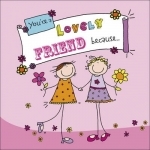
You're A Lovely Friend Because...
Book
Aiming to make life a little bit sweeter, this irresistible title forms part of the "Suga-Lump" gift...
Board Game News (72 KP) rated Glass Road in Tabletop Games
Jan 11, 2021
Fast gameplay, you can play this in 30 minutes, which is rare for a Uwe Rosenberg game. (3 more)
Awesome quality of the components.
Nice artwork.
The aspect of choosing cards is extremely fun.
The rondels might confuse new players and makes the game kind of hard to teach. (1 more)
The buildings are a bit "meh".
This is the best under-an-hour game by Uwe Rosenberg in our opinion, but it got its flaws.
Read it right here; https://www.boardgame-news.com/reviews/glass-road-review
Mark Anthony Ingham (2 KP) rated Happy! - Season 1 in TV
Jun 24, 2019
Comic book style (3 more)
Story
Action
Funny
Dark but with a twisted sense of humour
After seeing a trailer on netflix (in the UK) it sold it for me on the get go, this show is dark, twisted, funny, drink and drug fueled action.
One scene that stands out is when the main protagonist is playing cards and happy is around, i wont spoil it but when you get there, you will be dying with laughter.
One scene that stands out is when the main protagonist is playing cards and happy is around, i wont spoil it but when you get there, you will be dying with laughter.

S-net Mobile
Finance and Business
App
S-net Mobile, the Banque et Caisse d’Epargne de l’Etat, Luxembourg (BCEE)’s free mobile...

Banco General, S.A.
Finance
App
Access your Banco General accounts through your cell phone with a secure and easy to use...
